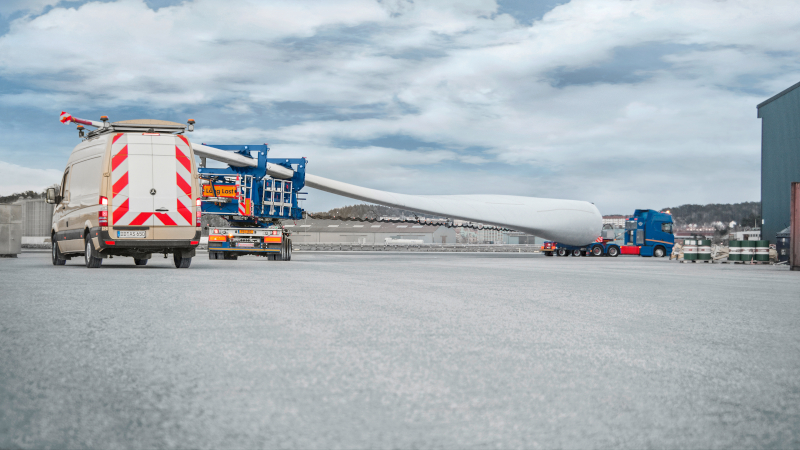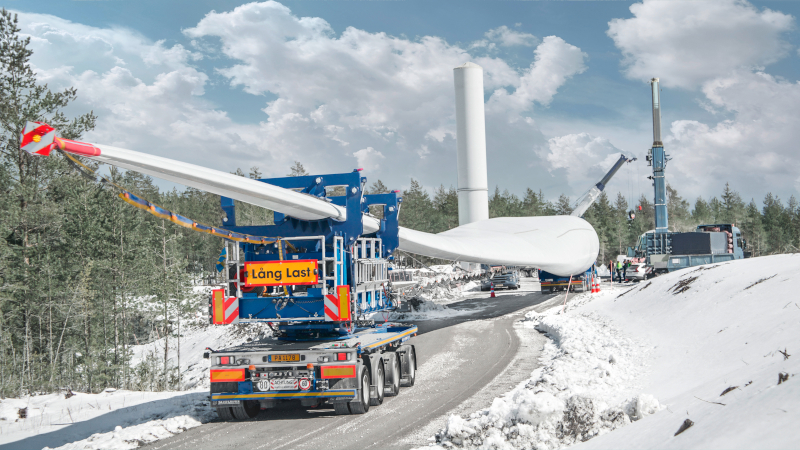Transport test case for Transpalux
9 December 2022Tii Scheuerle rotor blade transport systems used for first time by heavy transport company.
Belgian heavy-load specialist P. Adams has acquired three rotor blade transport systems (RBTS) from Tii Scheuerle. The forwarding company specialises in wind turbines, and its new RBTS are intended to handle the longest rotor blades on the market.
P. Adams received its first practical application in transporting just such a consignment, of 83-metre-long blades for a wind farm project in Sweden. 24 blades, for an eight-wind-turbine farm, had to be transported along mainly country roads, from the port city of Uddevalla, in western Sweden, to Knöstad, which is located further 170km to the north-east in Varmland. Each blade took two full nights to transport.
In the process, the convoy had to manoeuvre around numerous bends and, at the approach to the construction site itself, had to negotiate steep gradients and unpaved roads. The particular challenge of this task was the length of the load. The loaded tractor-trailer combination was 96 metres long and weighed around 65 tonnes – the load itself was around 30 tonnes.
Luxembourg-based company Transpalux, which belongs to the P. Adams Group, performed the task. “Although the bends were widened, our operators still had to constantly adjust the steering,” reports Stephan Adams, managing director of the group.
The Scheuerle RBTS consists of a two-axle jeep dolly with a free-turning device and a four-axle trailing unit. (It is also possible to mount the free-turning device directly on the truck tractor, but this means that a four-axle or five-axle semi-trailer tractor is required due to the high fifth-wheel load; Transpalux uses three-axle vehicles.)
“For blade lengths of more than 75 metres over long routes, there is no alternative to a trailer unit combination,” said Adams. The deployment marked a first for the RBTS at P. Adams. “Prior to this transport assignment, our drivers had only worked with telescopic semi-trailers and until now we had only had the opportunity to try out the RBTS in the form of a test load. In the end this wasn’t a problem for our drivers. They quickly became familiar with the equipment functions. It all worked out extremely well.”
The comparatively simple handling of the RBTS helped as well: “Our drivers mastered it in a very short time.”
One reason for choosing Tii Scheurle equipment was, he says, their understanding of the special requirements involved. This included the request for a functionality that enhances safety and stability. In order to keep the centre of gravity of the load as much as possible in the longitudinal axis of the vehicle, Adams required a lateral compensation feature that would shift the load to the left or right depending on the situation. Tii Scheuerle was able successfully to implement the requirement.
Adams also praised the driving characteristics of the RBTS. “The manoeuvrability of the trailing unit combination is very convincing,” he said. “The RBTS negotiates bends that cannot be mastered with a telescopic semi-trailer without having to remove crash barriers or carry out widening measures.”
The lift of up to two metres in the free-turning device is also large enough to accommodate obstacles such as surface unevenness and bumps in the road. These features reduced the time and effort involved in freeing up the route, which is why fewer approvals from the authorities were needed.
For empty runs the RBTS can be shortened to form a semi-trailer combination which meets the European standard dimensions of 2.55 metres wide and less than four metres height. The empty tractor-trailer combination weighs no more than 40 tonnes, which means that again, driving without a load requires less approval procedure.
“The trend in the industry clearly points to ever more powerful systems with increasingly larger-dimensioned components,” said Adams. “Without a trailing unit system, fleets that specialise in the transport of rotor blades are no longer futureproof.”


